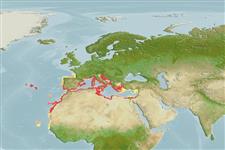Common names from other countries
Environment: milieu / climate zone / depth range / distribution range
Ecologia
; intervalo de profundidade 4 - 100 m (Ref. 4). Subtropical, preferred 20°C (Ref. 107945); 46°N - 13°N, 32°W - 36°E (Ref. 4)
Eastern Atlantic and the Mediterranean: from Lisbon, Portugal to Senegal, and the Mediterranean.
Length at first maturity / Tamanho / Peso / Idade
Maturity: Lm ? range ? - ? cm Max length : 45.0 cm TL macho/indeterminado; (Ref. 4); common length : 36.0 cm TL macho/indeterminado; (Ref. 441)
Carapace length: 12 cm. Occurs at depths between 4 and 100 m on rocky or sandy substrate. Feeds on mollusks, especially limpets (Patella sp.). Ovigerous females are observed from June to August (Ref. 4).
Life cycle and mating behavior
Maturidade | Reprodução | Desova | Ovos | Fecundidade | Larvas
Ovigerous females from June to August (Ref. 4).
Holthuis, L.B. 1991. (Ref. 4)
Status na Lista Vermelha da IUCN (Ref. 130435)
Status no CITES (Ref. 108899)
Not Evaluated
Not Evaluated
Uso pelos humanos
Pescarias: espécies comerciais
FAO - pescarias: landings | FishSource | Sea Around Us
Ferramentas
Fontes da internet
Estimates based on models
Preferred temperature
(Ref.
115969): 14.6 - 21.6, mean 18.7 (based on 246 cells).
Resiliência
Médio, tempo mínimo de duplicação da população 1,4 - 4,4 anos (K=0.2).
Vulnerabilidade
Low to moderate vulnerability (35 of 100).
